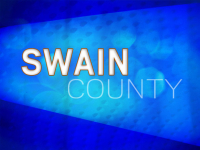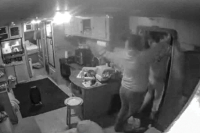Military icons in our midst
 Three military relics on display in the mountains honor the nation’s long and fabled history of duty and service to country.
Three military relics on display in the mountains honor the nation’s long and fabled history of duty and service to country.
These stoic sentinels transcend generations, transporting old war veterans back in time to the battlefields of their youth and kindling the first twinges of patriotism in the kids who scramble around on them.
For those who pass by them every day, they’ve become timeworn landmarks, a fixture of the local landscape, but it’s rare to have real military pieces of this caliber stationed in a small community for public exhibition.
ABOVE: The ‘Big Gun’
What: WWII anti-aircraft gun
Where: Clyde, in the heart of downtown on the town square and pedestrian plaza, along U.S. Business 19.
Related Items
Cherokee American Legion hopes to restore Cold War-era tank
Paul Crowley is probably best known for his milkshakes and splits at Soda Pop’s Ice Cream Parlor in Bryson City, but here’s a little known fact: he’s the only guy in Western North Carolina with the keys to an armored tank.
A Cold War-era tank acquired by Cherokee’s American Legion post — one of the last M60A3s ever made — has been a signature landmark in Cherokee for two decades. For a while, it was still drivable.
 “After 9/11, Homeland Security came out and had to decommission it to where it could not run,” Crowley said.
“After 9/11, Homeland Security came out and had to decommission it to where it could not run,” Crowley said.
Now, the only way to move the 63-ton tank — whose engine parts were welded together — is to tow it, and that’s no small feat.
“It takes a lot to move it,” Crowley said.
It was once prominently showcased in front of the tribal council house, but for years it’s been languishing in obscurity behind the Cherokee Fairgrounds.
“It is deteriorating,” Crowley said. “It has moss and weeds growing up on it and it looks really terrible.”
Its sides are covered in lichen, its cracks caked with fallen leaves and its treads sunk in the dirt.
Crowley is a member of the Steve Youngdeer American Legion in Cherokee, which has launched a campaign to restore the tank and hopefully relocate it to a spot where it can be more easily viewed and appreciated by the public.
“It is a major part of our military history,” Crowley said. It’s a unique claim to fame to have one of these icons.
“As far as a tank just sitting out there for the public to see, it is rare,” Crowley said.
The tank never saw active duty. Cherokee landed it specifically for public display when the army phased out the tank line in 1997 and moved up to a new model.
“They had no use for those last ones coming off the line,” Crowley said. “It was transported straight to Cherokee for static display.”
The tank is a trip down memory lane for any veteran who’s ever served in one. Crowley served in active duty in a tank patrolling the border of West Germany and Czechoslovakia during the Cold War and hopes the tank in Cherokee can serve as a living artifact of the nation’s military history for generations to come.
“It was a major part of my life,” said Crowley. “Crew men are tasked to their vehicles. Tanks are special to tank people because it becomes your home and the crew is your family.
The tank
What: A Cold War-era tank
Where: Cherokee, between tribal council and the Cherokee Fairgrounds on Tsali Boulevard.
Vietnam-era Huey like ‘time machine’ for mechanic
Gary Boyer did a double take when he caught the silhouette of helicopter blades out of the corner of his eye while driving through downtown Waynesville a couple years ago.
He pulled a U-turn, doubled-back and turned up an obscure side street where he came face-to-face with his maker — a Vietnam-era Huey sitting outside the Veterans of Foreign Wars post in Frog Level.
“These are icons,” Boyer said. “When you think of the ‘60s you think of Jimi Hendrix and the Beatles, but the picture is not complete until you see that Huey. Anyone who served in Vietnam, I don’t care what your job was, you knew when a Huey came. It had a voice of its own.”
 Boyer noticed immediately that this aging Huey needed help.
Boyer noticed immediately that this aging Huey needed help.
“It was getting water in it and it needed to be taken care of, but I don’t think people realized the damage that was going on,” Boyer said. “It was time to do something. It just couldn’t be put off any more.”
The languishing Huey on the VFW’s doorstep was a diamond in the rough, a rare bird that could technically be made air-worthy again with enough time and money.
“It is one of the few of these old Hueys around that has just about everything on it,” Boyer said, from the instrument gauges to controls to fuel lines. “But it needed attention, and they didn’t have anyone with any background they could fall back on to start a restoration process.”
Boyer was made for the job, however. He was a helicopter mechanic in Vietnam, and still knew every inch of the Huey.
“I can put these things together in my sleep,” Boyer said.
The chopper has been parked in front of the Waynesville VFW for at least two decades, but it’s on a side street and Boyer, who lives in Sylva, never knew about it.
“It was just a fluke I happened to drive by that day,” Boyer said.
Boyer promptly joined the VFW and soon had the keys.
“My primary goal to be part of the VFW was to take care of the helicopter,” Boyer said.
He has been plugging away at the restoration process for a year-and-a-half. Sometimes, when he’s working alone in the Huey’s belly, people and places long since forgotten come back to him.
“It is a time machine. You can close your eyes and take yourself back,” Boyer said.
Vietnam was the first war waged on the might of helicopters, a new breed of cavalry.
“In WWII and Korea, you are loaded up on trucks and rode in tanks. In Vietnam it was impossible to take ground transport anywhere. There just weren’t the roads,” Boyer said.
It was a brazen undertaking, to craft an all-new military tactic where battlefields weren’t clearly delineated.
“There was no front line. Anytime you set down outside an LZ (landing zone), you could get whacked — you weren’t welcome, let’s put it that way,” Boyer said.
Helicopter-based warfare took legions of helicopter maintenance crews, and Boyer was acutely aware of the lives that hinged on the job he did in the mechanics bay.
“A flying machine in war zones is a risky proposition,” Boyer said. “There was no margin for error. There was no compromise on maintenance. It was all or nothing. These helicopters needed constant attention and constant maintenance. You could not let something go out questionable.”
Boyer wasn’t just a ground mechanic. He was constantly in the air. Test flights were a daily part of the repair and maintenance regimen — the mechanics took up every helicopter they tinkered on. He also rode on missions — doubling as a door gunner — in case the Huey went down and a field repair was needed.
Boyer can still recall fixing a cross-threaded high-pressure fuel line in the middle of a rice paddy after a forced landing from the loss of transmission pressure.
He’s now reliving those days with a painstaking restoration of the Huey.
“My goal is to get it all fixed up and get it as close to where it was the day it was manufactured,” Boyer said. He hopes it can be an educational tool for the public, particularly kids.
When people see him with the doors of the helicopter flung open, surrounded by a bucket of tools, oil cloths and paint cans, they stop to see what’s up, peek their head in and sometimes offer to help.
With the interior nearly complete, he’s about to need it — “particularly when we get up on those rotor blades,” he said.
So far, Boyer’s been footing the bill himself. But he hopes to find money to help put a roof over the helicopter once it’s restored, with a nice pavilion and viewing platform of some sort.
Anyone interested in helping or donating can contact Boyer at This email address is being protected from spambots. You need JavaScript enabled to view it..
The chopper
What: A Vietnam-era Huey helicopter
Where: Waynesville, in front of the VFW on Miller Street above Frog Level









